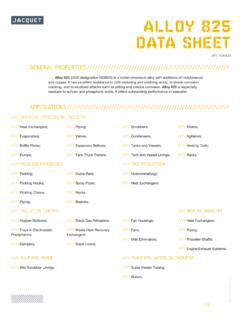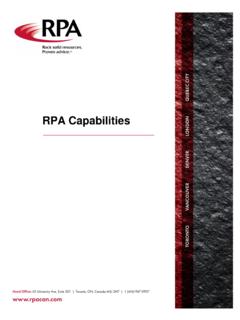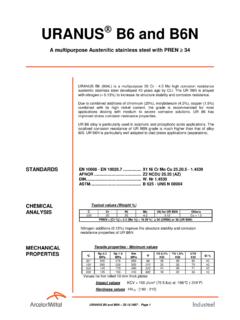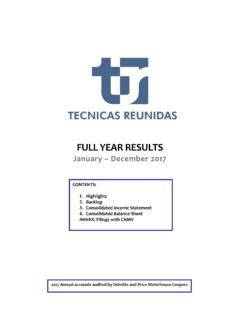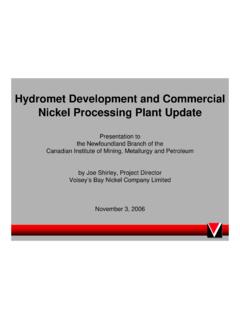Transcription of LEACHING Zn FROM THE LOW-GRADE ZINC OXIDE …
1 ISSN 0104-6632 Printed in Brazil Vol. 33, No. 04, pp. 907 - 917, October - December, 2016 *To whom correspondence should be addressed Brazilian Journal of Chemical Engineering LEACHING Zn FROM THE LOW-GRADE ZINC OXIDE ORE IN NH3-H3C6H5O7-H2O MEDIA Ma Ai-yuan1,2,3,4, Peng Jin-hui1,2,3,4, Zhang Li-bo1,2,3,4, Shiwei Li1,2,3,4*, Yang Kun1,2,3,4 and Zheng Xue-mei1,2,3,4 1 Yunnan Provincial Key Laboratory of Intensification Metallurgy, Kunming 650093, China. Phone: + 86 871 65174756; Fax: + 86 871 65138997 E-mail: 2 National Local Joint Laboratory of Engineering Application of Microwave Energy and Equipment Technology, Kunming, Yunnan 650093, China.
2 3 Key Laboratory of Unconventional Metallurgy, Ministry of Education, Kunming 650093, China. 4 Faculty of Metallurgical and Energy Engineering, Kunming University of Science and Technology, Kunming 650093, China. (Submitted: March 25, 2015 ; Revised: June 15, 2015 ; Accepted: July 21, 2015) Abstract - In this research, the effect of different citric acid concentrations, ammonia concentration, temperature, LEACHING time, stirring speed and liquid-to-solid ratio on the zinc LEACHING from LOW-GRADE zinc OXIDE ore in a NH3-H3C6H5O7-H2O system were studied. The results showed that the zinc LEACHING rate is only when the citric acid concentration is 0 M, and the LEACHING efficiency of Zn increased with increasing citric acid concentration.
3 Under the conditions: citric acid concentration of M, ammonia concentration of 6 M, temperature of 25 C, LEACHING time of 60 min, stirring speed of 300 rpm and the starting solid-to-liquid ratio of 1:5, of Zn is leached. The mineralogical changes of the LOW-GRADE zinc OXIDE ores during the processes were characterized by X ray fluorescence (XRF), X ray powder diffraction (XRD), Scanning Electron Microscopy associated with Energy Dispersive Spectroscopy (SEM EDS) and Fourier transform infrared spectroscopy (FT IR). From the evidence we deduced that citric ions complexed with zinc ions, forming a Zn-citrate complex.
4 As a result, the zinc LEACHING rate was improved without the risk of pollution or pretreatment. This makes it as a good choice for a more ecological treatment of hemimorphite. Keywords: LOW-GRADE zinc OXIDE ores; Hemimorphite; Ammonia LEACHING ; Citric acid. INTRODUCTION Considering the huge reserves of low grade zinc OXIDE ores with high alkaline gangue (CaO and MgO) in the world (Li et al., 2010), which is hard to handle by the traditional zinc smelting methods, re-covering zinc from low grade OXIDE zinc ores has been a matter of discussion recently. The leach-sol-vent extraction-electro-winning process route is the most common method of extraction of zinc from LOW-GRADE zinc OXIDE ores (de Wet and Singleton, 2008).
5 This is a material which can be processed by flotation (Irannajad et al., 2009; Navidi Kashani and Rashchi, 2008; Li et al., 2013) and acid- LEACHING methods (Irannajad et al., 2013; Xu et al., 2010; Xu et al., 2012; Li et al., 2010; He et al., 2010; He et al., 2011). However, sulfuric acid LEACHING could not ef-fectively recover zinc from a low grade OXIDE ore because of substantial iron dissolution (Yang et al., 2013). Because of the complexities of mineralogical composition and structure, separation of zinc OXIDE minerals from their gangues by flotation is an ex-tremely complex process (Majid et al.)
6 , 2014). Hence, with the high consumption of LEACHING acid, the treat-ment of LOW-GRADE oxidized zinc ores by hydrometal-lurgical methods is expensive and complex. 908 Ma Ai-yuan, Peng Jin-hui, Zhang Li-bo, Shiwei Li, Yang Kun and Zheng Xue-mei Brazilian Journal of Chemical Engineering The application of alkaline LEACHING techniques has become an increasingly important aspect in the recovery of base and precious metals from complex low grade zinc OXIDE ores (Santos et al., 2010; Ding et al., 2010; Yin et al., 2010). However, alkaline LEACHING processing is often confronted with the problem of LOW-GRADE complex ores, especially zinc silicate.
7 The low solubility of these ores does not usually allow for the recovery of the target metal, even by direct chemical LEACHING in many LEACHING reagents (Zhao et al., 2009). Extracting zinc from hemimorphite by LEACHING in sodium hydroxide solu-tion requires high temperature, pressure and alkalin-ity (Chen et al., 2009). Currently, hydrometallurgy in ammonia has been considered as a prospective me-dium for the LEACHING of complex zinc ores of both OXIDE and sulfide types (Li et al., 2014). The use of organic acids for the extraction of metals has been studied by many researchers. It was reported that low molecular weight citric acid has been found to be effective in removing heavy metals by forming soluble complexes and chelates with metal ions (Chen et al.)
8 , 2003; Hongki et al., 2013), and there is no concern about environmental prob-lems after the treatment. Citric acid was found to be more active than H2SO4. In hydrometallurgical treat-ments, the ability to recover metals or metal oxides depends on their chemical reactivities (Larba et al., 2013). So citric acid seems more appropriate to use as a less costly and more environmentally friendly leachant. Several papers have been published on the coor-dination of citric acid and transition metals, lead citrate (Kourgiantakis et al., 2000), tungsten citrate (Zhang et al., 2003), aluminum citrate (Matzapetakis et al.
9 , 1999) and germanium citrate (Willey et al., 2001). Based on previous work, a new hydrometal-lurgical process for LOW-GRADE zinc OXIDE ore is put forward. In this work, the effect of the concentration of citric acid, ammonia concentration, temperature, LEACHING time, stirring speed and liquid-to-solid ratio on the LEACHING of zinc from low grade zinc OXIDE ore in the NH3-H3C6H5O7-H2O system was studied. The aim of this work was to develop a new hydro-metallurgical technology, which intends to provide a green and economic method to extract zinc from LOW-GRADE zinc OXIDE ores. MATERIALS AND METHODS Experimental Materials The LOW-GRADE zinc OXIDE ores used were given by Lanping County of Yunnan Province, China.
10 The main chemical composition of the LOW-GRADE zinc OXIDE ores obtained by chemical analysis is listed in Table 1. It can be observed that silica (SiO2) and a high content of alkaline gangues (CaO + MgO) are the main components of the ore. The zinc content in this ore, around , is considered to be low for a successful pyrometallurgical treatment for zinc re-covery (Dutra et al., 2006), which leads to the greater interest in the hydrometallurgical treatment. The XRD spectrum of the LOW-GRADE zinc OXIDE ore is shown in Figure 1. The XRD analysis shows that silica (SiO2), calcium carbonate (CaCO3), lead carbonate (PbCO3), and hemimorphite (Zn4Si2O7(OH)2 H2O) are the main chemical components.










